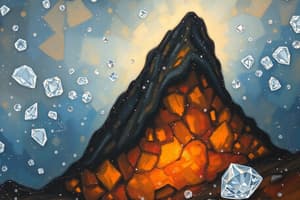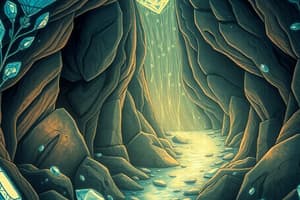Podcast
Questions and Answers
What is a primary characteristic of diamond aggregates?
What is a primary characteristic of diamond aggregates?
- They are made up of many tiny randomly oriented diamond crystals. (correct)
- They consist of large single diamond crystals.
- They are porous and lightweight.
- They contain various non-diamond minerals.
Where do superdeep diamonds typically form within the Earth's structure?
Where do superdeep diamonds typically form within the Earth's structure?
- In volcanic regions
- At the earth's surface
- In the transition zone and lower mantle (correct)
- In the upper mantle
Which type of volcanic eruption is primarily responsible for transporting diamonds to the earth’s surface?
Which type of volcanic eruption is primarily responsible for transporting diamonds to the earth’s surface?
- Rhyolitic eruption
- Basaltic eruption
- Andesitic eruption
- Kimberlite eruption (correct)
What is a characteristic feature of CLIPPIR diamonds?
What is a characteristic feature of CLIPPIR diamonds?
What is a significant factor that allows diamonds to be dated indirectly?
What is a significant factor that allows diamonds to be dated indirectly?
What is the primary cause of the blue color in blue diamonds?
What is the primary cause of the blue color in blue diamonds?
What is a characteristic of lamproite compared to kimberlite?
What is a characteristic of lamproite compared to kimberlite?
Which type of diamond forms under conditions caused by a meteorite impact?
Which type of diamond forms under conditions caused by a meteorite impact?
How deep do diamonds typically form in the Earth's mantle?
How deep do diamonds typically form in the Earth's mantle?
How do the inclusions found in blue diamonds differ from those in other types of diamonds?
How do the inclusions found in blue diamonds differ from those in other types of diamonds?
What happens to diamonds if the conditions under which they formed change?
What happens to diamonds if the conditions under which they formed change?
What is the shape of the formation produced by a kimberlite eruption?
What is the shape of the formation produced by a kimberlite eruption?
What defines the distinction of superdeep diamonds compared to crustal diamonds?
What defines the distinction of superdeep diamonds compared to crustal diamonds?
Where are diamond-bearing lamproites commonly found?
Where are diamond-bearing lamproites commonly found?
Which minerals are typically found in inclusions within superdeep diamonds?
Which minerals are typically found in inclusions within superdeep diamonds?
Which characteristic defines carbonado diamonds?
Which characteristic defines carbonado diamonds?
Which type of diamond forms deeper in the mantle than typical diamonds?
Which type of diamond forms deeper in the mantle than typical diamonds?
What characteristic defines CLIPPIR diamonds?
What characteristic defines CLIPPIR diamonds?
In what kind of rocks do most diamonds form?
In what kind of rocks do most diamonds form?
Under what conditions do diamonds typically form?
Under what conditions do diamonds typically form?
What process allows carbon atoms to bond and form diamonds?
What process allows carbon atoms to bond and form diamonds?
Where are cratons typically found?
Where are cratons typically found?
Which diamond type is characterized by its high purity and low levels of inclusions?
Which diamond type is characterized by its high purity and low levels of inclusions?
What is the role of the lithosphere in diamond formation?
What is the role of the lithosphere in diamond formation?
Very Small Crustal diamonds are typically used for ....?
Very Small Crustal diamonds are typically used for ....?
" Resorbed " means ....?
" Resorbed " means ....?
The subduction of oceanic plates creating CLIPPER diamonds results from what type of material?
The subduction of oceanic plates creating CLIPPER diamonds results from what type of material?
What type of environment do Julian Diamonds form?
What type of environment do Julian Diamonds form?
How do diamond atoms form differently than graphite ?
How do diamond atoms form differently than graphite ?
What is the main rock type associated with diamond-bearing eruptions that is more common than lamproite?
What is the main rock type associated with diamond-bearing eruptions that is more common than lamproite?
Which type of eruption typically produces a carrot-shaped formation?
Which type of eruption typically produces a carrot-shaped formation?
What geological process is responsible for delivering diamonds to the surface?
What geological process is responsible for delivering diamonds to the surface?
Where are diamond-bearing lamproites mainly found in relation to cratons?
Where are diamond-bearing lamproites mainly found in relation to cratons?
Which statement is true about the metamorphic stability of diamonds?
Which statement is true about the metamorphic stability of diamonds?
What geological process primarily brings diamonds closer to the Earth's surface?
What geological process primarily brings diamonds closer to the Earth's surface?
During subduction, which plate typically sinks beneath the other?
During subduction, which plate typically sinks beneath the other?
What type of volcanic rock is typically produced by lamproite eruptions?
What type of volcanic rock is typically produced by lamproite eruptions?
Which type of rock is primarily responsible for most of the diamond deposits found in the Earth?
Which type of rock is primarily responsible for most of the diamond deposits found in the Earth?
What is the typical depth where diamonds form in the Earth's mantle?
What is the typical depth where diamonds form in the Earth's mantle?
What is the estimated temperature range necessary for natural diamond formation?
What is the estimated temperature range necessary for natural diamond formation?
Which statement describes the explosive nature of lamproite eruptions compared to kimberlite eruptions?
Which statement describes the explosive nature of lamproite eruptions compared to kimberlite eruptions?
What type of geological structure is associated with the formation of superdeep diamonds?
What type of geological structure is associated with the formation of superdeep diamonds?
What process describes the interaction of fluids or melts with rocks during diamond formation?
What process describes the interaction of fluids or melts with rocks during diamond formation?
What is the pressure range thought to be necessary for the formation of diamonds?
What is the pressure range thought to be necessary for the formation of diamonds?
Which model is thought to describe the formation of the majority of mined diamonds?
Which model is thought to describe the formation of the majority of mined diamonds?
What process is theorized to be linked to the formation of CLIPPIR diamonds?
What process is theorized to be linked to the formation of CLIPPIR diamonds?
How does the transport of diamonds from the mantle to the surface predominantly occur?
How does the transport of diamonds from the mantle to the surface predominantly occur?
What is a major characteristic of crustal diamonds related to their formation location?
What is a major characteristic of crustal diamonds related to their formation location?
What type of fluid is believed to contribute to the formation of Juína diamonds?
What type of fluid is believed to contribute to the formation of Juína diamonds?
What is a characteristic of blue diamonds regarding their origin?
What is a characteristic of blue diamonds regarding their origin?
Which type of diamond is most commonly linked to the impacts of meteorites?
Which type of diamond is most commonly linked to the impacts of meteorites?
What mainly differentiates superdeep diamonds from crustal diamonds in terms of formation depth?
What mainly differentiates superdeep diamonds from crustal diamonds in terms of formation depth?
What is a function of pressure in the formation of diamonds in the mantle?
What is a function of pressure in the formation of diamonds in the mantle?
What layer is molten?
What layer is molten?
Flashcards
Superdeep Diamonds
Superdeep Diamonds
Diamonds formed deep within Earth's mantle, typically in the transition zone (410-660 km) or lower mantle (>660 km).
Formation of Superdeep Diamonds
Formation of Superdeep Diamonds
Formation is always linked to subducted oceanic plates.
CLIPPIR Diamonds
CLIPPIR Diamonds
Large, inclusion-free diamonds with irregular shapes, often showing signs of surface dissolution during transport.
Metallic Melt Inclusions
Metallic Melt Inclusions
Signup and view all the flashcards
Blue Diamonds
Blue Diamonds
Signup and view all the flashcards
Juína Diamonds
Juína Diamonds
Signup and view all the flashcards
Crustal Diamonds
Crustal Diamonds
Signup and view all the flashcards
Carbonado Diamonds
Carbonado Diamonds
Signup and view all the flashcards
Diamond Source Locations
Diamond Source Locations
Signup and view all the flashcards
Mantle Convection
Mantle Convection
Signup and view all the flashcards
Diamond Aggregate Structure
Diamond Aggregate Structure
Signup and view all the flashcards
Spreading Ridge
Spreading Ridge
Signup and view all the flashcards
Subduction
Subduction
Signup and view all the flashcards
Diamond Age Methodology
Diamond Age Methodology
Signup and view all the flashcards
Diamond Transport Method
Diamond Transport Method
Signup and view all the flashcards
Eclogite
Eclogite
Signup and view all the flashcards
Cratons
Cratons
Signup and view all the flashcards
Kimberlite Eruption
Kimberlite Eruption
Signup and view all the flashcards
Mantle Keels
Mantle Keels
Signup and view all the flashcards
Lamproite Eruption
Lamproite Eruption
Signup and view all the flashcards
Diamond Formation Conditions
Diamond Formation Conditions
Signup and view all the flashcards
Diamond Metastability
Diamond Metastability
Signup and view all the flashcards
Diamond-Bearing Pipe
Diamond-Bearing Pipe
Signup and view all the flashcards
Peridotite
Peridotite
Signup and view all the flashcards
Kimberlite Formation Shape
Kimberlite Formation Shape
Signup and view all the flashcards
Eclogite (source)
Eclogite (source)
Signup and view all the flashcards
Lamproite Formation Shape
Lamproite Formation Shape
Signup and view all the flashcards
Kilobar
Kilobar
Signup and view all the flashcards
Geothermal Gradient
Geothermal Gradient
Signup and view all the flashcards
Deepest Earth Hole Depth
Deepest Earth Hole Depth
Signup and view all the flashcards
Lithospheric and Superdeep Models
Lithospheric and Superdeep Models
Signup and view all the flashcards
Superdeep Diamonds
Superdeep Diamonds
Signup and view all the flashcards
Diamond Aggregate
Diamond Aggregate
Signup and view all the flashcards
Diamond Source Locations (Industrial)
Diamond Source Locations (Industrial)
Signup and view all the flashcards
Diamond Age (Methodology)
Diamond Age (Methodology)
Signup and view all the flashcards
Diamond Transport
Diamond Transport
Signup and view all the flashcards
Kimberlite Eruption
Kimberlite Eruption
Signup and view all the flashcards
Lamproite Eruption
Lamproite Eruption
Signup and view all the flashcards
Diamond Metastability
Diamond Metastability
Signup and view all the flashcards
Diamond-Bearing Pipe
Diamond-Bearing Pipe
Signup and view all the flashcards
Deepest Hole Depth
Deepest Hole Depth
Signup and view all the flashcards
Mantle Convection
Mantle Convection
Signup and view all the flashcards
Spreading Ridge
Spreading Ridge
Signup and view all the flashcards
Subduction
Subduction
Signup and view all the flashcards
Eclogite
Eclogite
Signup and view all the flashcards
Cratons
Cratons
Signup and view all the flashcards
Mantle Keels
Mantle Keels
Signup and view all the flashcards
Diamond Formation Conditions
Diamond Formation Conditions
Signup and view all the flashcards
Peridotite
Peridotite
Signup and view all the flashcards
Superdeep Diamonds
Superdeep Diamonds
Signup and view all the flashcards
Kilobar
Kilobar
Signup and view all the flashcards
Geothermal Gradient
Geothermal Gradient
Signup and view all the flashcards
Lithospheric and Superdeep Models
Lithospheric and Superdeep Models
Signup and view all the flashcards
Superdeep Diamond Formation
Superdeep Diamond Formation
Signup and view all the flashcards
CLIPPIR Diamonds
CLIPPIR Diamonds
Signup and view all the flashcards
Blue Diamond Origin
Blue Diamond Origin
Signup and view all the flashcards
Juína Diamond Formation
Juína Diamond Formation
Signup and view all the flashcards
Crustal Diamond
Crustal Diamond
Signup and view all the flashcards
Carbonado Diamond
Carbonado Diamond
Signup and view all the flashcards
Ringwoodite/Wadleyite
Ringwoodite/Wadleyite
Signup and view all the flashcards
Bridgmanite, Calcium Perovskite, Garnet
Bridgmanite, Calcium Perovskite, Garnet
Signup and view all the flashcards
Study Notes
Diamond Formation
- Diamonds are made of carbon
- Diamonds have strong 3-dimensional bonds
- Graphite has strong parallel bonds with weak bonds between them
- Diamonds form in the Earth's mantle
- The Earth's crust is thin compared to the lower layers
- The continental crust is thicker than the oceanic crust
- The mantle layer is between the crust and the outer core
- The lithosphere includes the crust and the uppermost part of the mantle
- Plate tectonics involves the movement of 15 plates
- Mantle convection drives plate movement
- Diamonds form at depths of 250-300 km in the mantle
Diamond Formation Sources
- Diamonds primarily form in peridotite and eclogite rocks
- Peridotite is a type of igneous rock
- Eclogite is a metamorphic rock formed from oceanic crust
- Diamond formation needs high temperature (900-1400°C) and pressure (40-80 kilobars)
- Two models for diamond formation: lithospheric and superdeep
- Superdeep diamonds form in the transition zone and lower mantle (410-660 km and >660 km)
- These diamonds often include unusual minerals like ringwoodite, wadsleyite, and Bridgmanite
Diamond Formation Processes
- Diamonds form through metasomatism, the process of fluids or melts interacting with rocks
- Fluid and melt reactions change rocks' composition as they move through the mantle
- Superdeep diamonds, like CLIPPIR, blue, and Juína, often form through subducted oceanic plates
- Carbon atoms must bond without oxygen at extreme pressure and heat
- Metallic melt inclusions are associated with some diamonds
- Trace amounts of boron can create blue diamonds
- Crustal diamonds form near the Earth's surface through impacts
- Large impact events can convert carbon to diamond
- Diamonds are found in Kimberlite and Lamproite volcanic eruptions
Diamond Characteristics
- Carbonado diamonds are an aggregate of intergrown crystals and are very tough
- Diamonds are pure carbon without radioactive elements
- Determining a diamond's age is difficult but can be inferred from mineral inclusions
- Diamonds can be transported to the surface in kimberlite and lamproite eruptions
- Kimberlite is richer in magnesium than lamproite, both lack feldspar
- High temperature and pressure needed for diamond formation
Studying That Suits You
Use AI to generate personalized quizzes and flashcards to suit your learning preferences.





